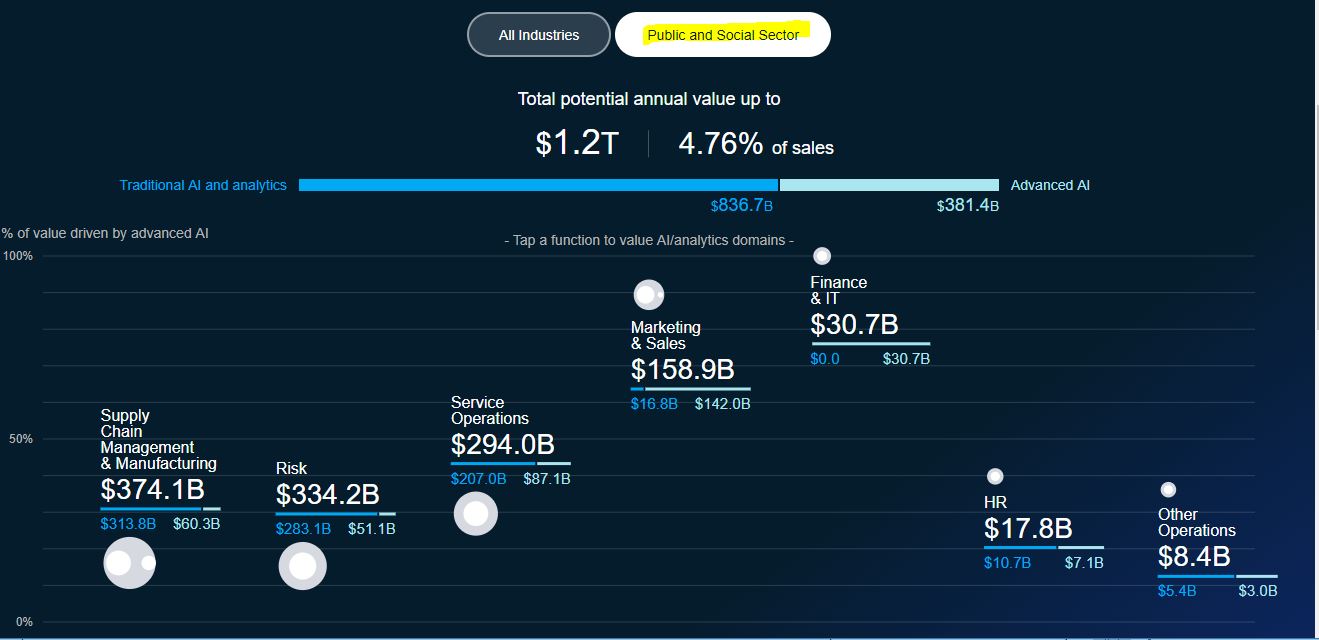- 21 November 2018
- Posted by: Peter Lunio
- Categories: Analytics, Artificial Intelligence, Business Initiative, Operating Model
I read with interest an article last week from Mckinsey were they had attempted to identify the potential benefits in dollars per annum per industry sector of the implementation of AI and Analytics initiatives. See below.

Their data visualisation above shows the potential business applications and economic value for a range of analytics and artificial intelligence (AI) techniques. It is based on a study of more than 400 user cases, covering 19 industries and nine business functions. For each user case, Mckinsey has estimated a range of the annual value potential of applying AI and other analytics across the entire economy based on the structure of the global economy in 2016. They have aggregated these values at the industry, function and domain levels and display the high end of the value range in the visualization. The one I am showing you is for the Public and Social Sector. If you want to check out the other 18 sectors then click on the link here.
https://www.mckinsey.com/business-functions/mckinsey-analytics/our-insights/the-executives-ai-playbook?page=industries/
For those of you who are hard pressed for time, I have tried to interpret the results for those of you in the Public and Social sector to give you some pointers as to where you should be seeking the benefits of your AI and analytics initiatives and what level of sophistication you need to apply.
Firstly, of the 19 industry sectors, they have analysed, Public and Social Sector was the third highest in terms of total benefits, behind retail and consumer packaged goods.
In the table below I have attempted to show you where they see those benefits being achieved and to give you a sense of the proportion that each business function of the total potential savings is estimated to deliver.
So for example, what the table shows is that Risk Modelling which represents 28% of the estimated total potential annual savings in the Public and Social Sector, these savings Mckinsey claim can be delivered primarily by using Traditional AI and Analytics* techniques. Whereas Customer Service Management which is estimated to deliver 13% of your savings will require more Advanced AI* techniques.
| Element | The proportion of overall estimated savings | Traditional AI & Analytics | Advanced AI |
| Risk Modelling | 28% | 85% | |
| Predictive Service Intervention | 24% | 70% | |
| Procurement Spend Analytics | 23% | 82% | |
| Customer Service Management | 13% | 96% | |
| Predictive Maintenance | 8% | 87% | |
| Accounting & IT | 2% | 100% | |
| Hiring & Retention | 1.50% | 63% | |
| Workforce Productivity & Efficiency | 1% | 64% |
What this gives you is a starter for 10 in terms of where to prioritise your AI/Analytics initiatives in order to give you your biggest benefits and where to apply the less sophisticated AI techniques to gain the quickest return.
Insight – interpreting the table then the areas to focus on then are Risk Modelling, Procurement analytics and predictive maintenance based on benefits potential and level of technical sophistication required.
*Traditional AI & Analytics – Traditional machine learning (eg, clustering) and statistical techniques (eg, basic regression)
*Advanced AI – Deep learning neural networks (eg, convolutional neural networks)

